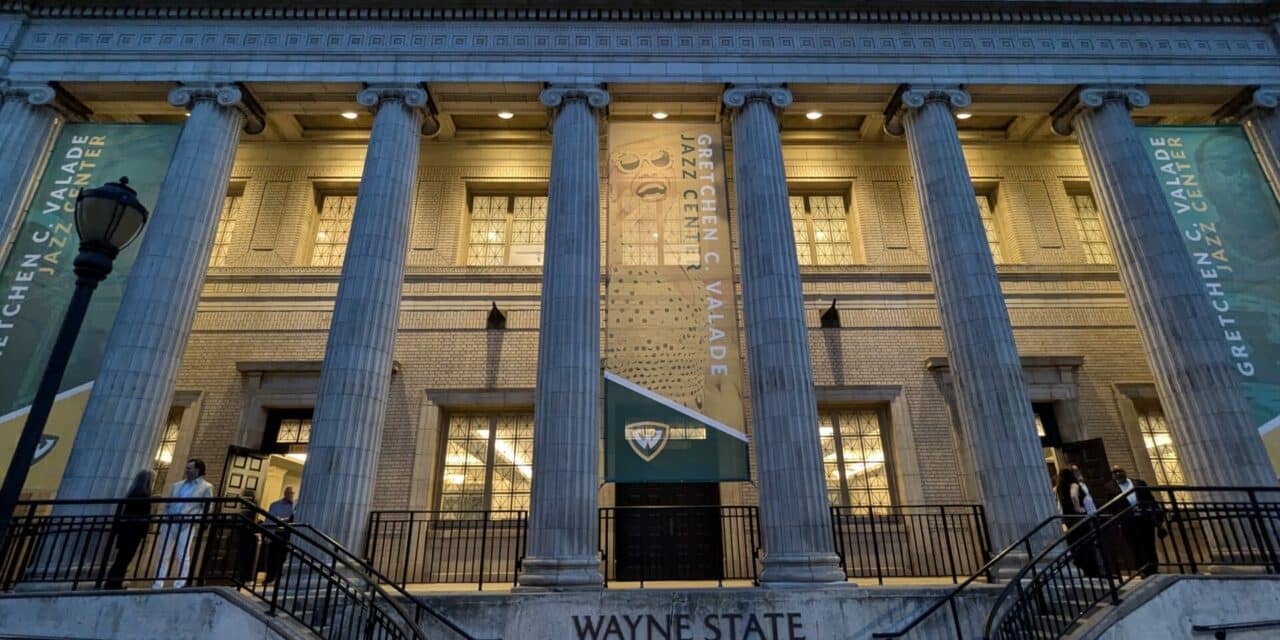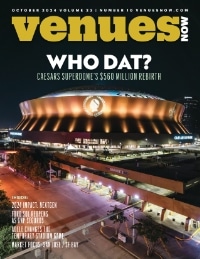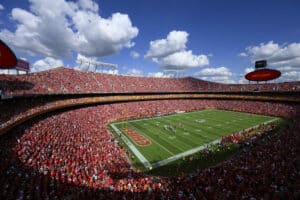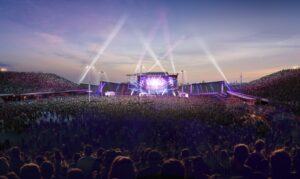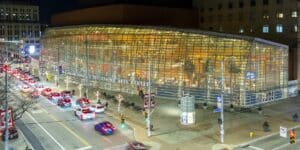WAYNE STATE SHUFFLE: Gretchen C. Valade Jazz Center opened its doors in August with a VIP preview, followed by Detroit Jazz Festival performances. (Courtesy venue)
Three venues include Dee Dee Bridgewater’s club
It’s been a long-winding road to the opening of the Gretchen C. Valade Jazz Center in Detroit — not unlike a detailed, improvisational performance, with twists, turns and surprises that improve the final product.
The multipurpose center, part of Wayne State’s $70-million-plus Hilberry Gateway district on the Wayne State University campus in the city’s Midtown area, opened its doors at the end of August with a VIP preview that led into three nights of hosting performances for the 45th annual Detroit Jazz Festival.
It’s named for the late Gretchen C. Valade, an heiress of the Carhartt clothing company and jazz enthusiast who died at the end of 2022. Her family provided $9.5 million in jazz center funding.
“This was built with jazz in mind, but it doesn’t have to be jazz to be in there,” explains Chris Collins, the university’s Gretchen C. Valade Endowed Chair in Jazz Studies and the President and Artistic Director of the Detroit Jazz Festival Foundation. “It’s a variable place. The idea is to encourage and help facilitate artists from all over, in different genres, to create, to integrate, to consider — maybe even to investigate the jazz world.”
The goal is to have the 28,300-square-foot facility rockin’ into the future, and even beyond the genre spotlighted in its name. What patrons will find is certainly a venue made for music, period.
The center features three distinct spaces for events. The Detroit Jazz Hall seats 325 and was designed and tuned acoustically, for jazz, by Mark Holden and his firm Jaffe Holden. Downstairs the intimate Dee Dee Bridgewater’s, named after the Grammy Award-winning singer who began her career in Flint, Mich., can hold 120 in a club setting, with an attached Detroit Jazz Festival Cafe for spillover. Upstairs is a VIP-style lounge, named for Collins by a benefactor, that will host intimate performances and other gatherings.
“Gretchen herself wanted this to be a professional venue for live jazz performance and not necessarily be focused on a teaching instrument as so many of our other buildings are,” says senior project manager Ron Kahle. “That’s everything we’ve done. All the restructuring and accommodations we’ve made has been for the purpose of the sound and making sure that sound is the best it can be for live jazz.”
Valade, a composer herself became known as Detroit’s “Angel of Jazz” after endowing the festival as well as opening a supper club, the Dirty Dog Jazz Cafe in the suburb of Grosse Pointe, and launching a record label.
“Jazz was beyond a passion for Gretchen,” her namesake granddaughter Gretchen R. Valade said during the VIP opening. “Jazz was her life and it was what motivated her. She was always searching for opportunities to promote jazz, any way she could find. She put her heart and her soul into making sure that the music was accessible to all.”
Collins affirms that Carhartt had “such a beautiful vision. It was not tainted by anything. She really loved the music.” The two began discussing the idea of a venue in downtown Detroit and, after considering a number of commercial properties, they began talking to Wayne State about endowment possibilities on campus.
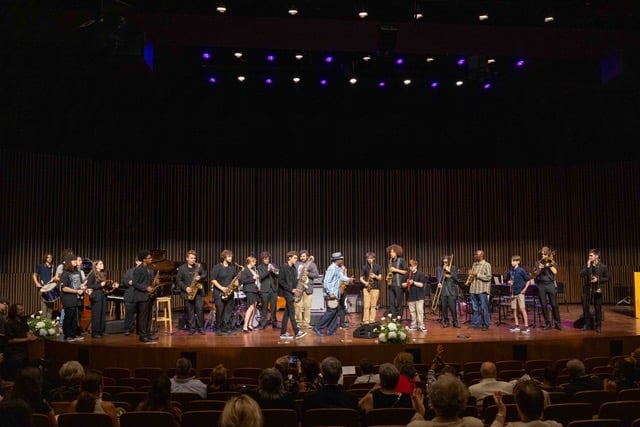
Dr. Valade’s Brass Band shown at the new Gretchen C. Valade Jazz Center in Detroit. (Courtesy venue)
The building that now houses the Valade Center presented such an opportunity. Built in February 1917 as the First Church of Christ Scientist — with 22 rooms and a 60-foot stage — it was acquired by Wayne State in 1961 and remodeled into the Hilberry Theatre for plays and musicals. As plans to update the school’s theatrical facilities moved forward, the building, designated a historical landmark, was going to be vacated, with no specific plans, and discussions began about an elite venue for performing, teaching, mentoring, recording and other endeavors.
“(Valade) didn’t want to put her name on it,” Collins said. “We said, ‘Look, this can stand as a testimonial to how important you are in the jazz world … to have that last forever and maybe give us some flexibility to continue the tradition of making down the barriers and having the music be for everyone.”
Wayne State broke ground on the Valade Center during 2018, while the building was still in use as a theater. Kahle says construction began in earnest during January of 2023, starting with hazardous material identification and removal and the tricky business of staying within the guidelines of the historic site designation.
“The existing building had such good structure for the new use; we have really good bones, as they say in the industry,” Kahle explains. “That allows us to be successful in a repurposing of this building. We’re keeping it, not destroying it, not removing it, not knocking it down to build a new one.”
The most significant work was one in the main hall, where three-quarters of the stage was reconstructed with materials Kahle says were “conducive to the harmonics of the room.” Walls were constructed after acousticians studied the room for optimal Sound Transmission Coefficiency.
“The beauty is the design,” Collins says. “You have a sense of warmth and closeness between you and your bandmates that you don’t feel like you’re filling a big space, nor do you feel like your sound, the core of your sound and the midrange, is leaving you. And (in the seats) even the subtlest of dynamics can be heard: the spit on the reed, as we say, or the rosin on the bow. Any seat is consistent to the next. It’s really quite a lovely acoustic thing.”
Among the highlights of the Detroit Jazz Hall is a new Steinway Model D 9ft Concert Grand Piano selected by a committee of Detroit area players from four offered by the company.
The tech package includes a DiGiCo SD9 digital audio mixing console for live audio; Shure ULXD wireless microphones; an ETC Eos Lighting Console and a Panasonic 14K projector with motorized retractable video screen for live performance.
The theater’s control room is being rebuilt and will house a separate Midas M32 digital audio console; studio grade microphones; an Apple Mac Pro computer; and a NewTek Tricaster for 4K camera control and live streaming. Three stationary cameras have been installed for multi-cam video recording and live streaming, along with two additional locations for more camera angles.
A network of dressing rooms, as well as a green room, accommodate everything from solo performers to large “gang” ensembles, all equipped with monitors to track what’s happening on stage.
Dee Dee Bridgewater’s has its own restored Steinway Model C seven-foot grand piano, with a Midas M32 digital mixing console; studio grade microphones; an ETC CS20 lighting console; and a QSC speaker system for its live, streaming and recording performances.
Both spaces will make use of a touring-grade instrumental backline that includes DW Collectors Series drum sets; DW 9000 series drum hardware; Zildjian K Custom cymbals; Aguilar and Gallien Krueger bass amplifiers; Fender Twin guitar amplifiers and an assortment of additional percussion.
The big room had a preview in April, when the jazz festival announced its 2024 lineup with performances by Blade and others.
On the night before the VIP opening it hosted a panel discussion about Alice Coltrane with her son Ravi, daughter Michelle John Coltrane Quartet bassist Reggie Workman. Bridgewater — who sang the Valade composition “The Lights of Detroit” with the Wayne State Jazz Legacy Big Band — and harpist Brandee Younger were among the performers at the grand opening.
The venue got an unexpected workout on Aug. 30 when predictions for heavy storms drove the festival’s opening night sets, and Alice Coltrane tribute and Blade’s Fellowship Band, indoors for streaming instead. That was in addition to planned weekend performances by the Kurt Rosenwinkel Trio, Jon Cowherd and others.
“I’ve gone out of my way to talk with each and every performer, when I can, to get a sense of how they feel the room is and what we can do to make it better,” Kahle says. He was particularly heartened that Brian Blade, this year’s Detroit Jazz Festival artist-in-residence, chose to rehearse his ensembles at the Valade Center rather instead of the actual stages.
“With his experience, his history, his ear, his understanding of acoustics and combining acoustic and electronically modified and amplified musical instruments, to have him want to have his rehearsals there — that was a good checkmark in our direction,” Kahle notes.
Finishing touches are still being put on the building, including building an elevator and loading dock, plus ADA accessibility measures.
In the meantime Collins is working on the programming of the buildings. Wayne State’s music department has a number of performances planned for its ensembles, and Collins has invited other Detroit area venues, concert promoters and talent buyers to tour the facility and talk about collaborating on a variety of events.
“There are so many possibilities,” says Collins, who also expects the jazz festival to be “more aggressive” in including the Valade Center in the future. “I know Gretchen would have envisioned all of us working together in a way that benefits our community as a whole and partnering on different kinds of events so that we feed off each other and create opportunities. We’re going to work hard to support what’s already here and still bring something new to the community that enhances that.”
